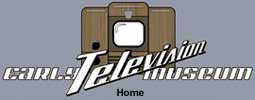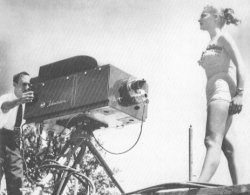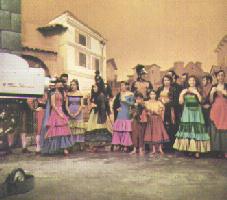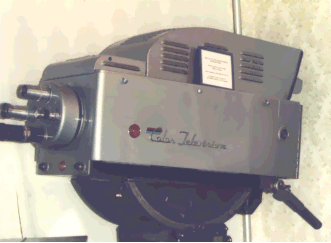Ed Reitan's Color Television History
Color Television Camera Development
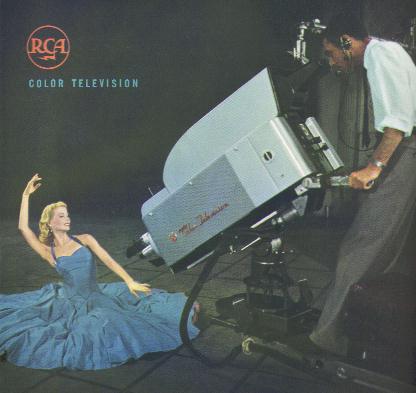 Glamour Photo of the TK-40 Color Cameraat the Colonial Theater, New York in 1953 The First Live Pick-Up Color CamerasRCA began live camera development for its simultaneous color television system as early as 1946-47. RCA Laboratories initially implemented a flying-spot camera that could photograph an area the size of a person's face. A monochrome CRT was imaged through lenses onto the subject's face, and red, green, and blue sensitive photocells picked up the reflected light.
Shortly thereafter, RCA scientists mounted three monochrome image orthicon cameras onto an optical table. Light from the subject passed through a configuration of dichroic mirrors which split the light into primary colors. The dichroics routed the light into the three identical objective lenses of the three cameras. The camera therefore had only a single fixed focal length, and the three objectives were individually focused.
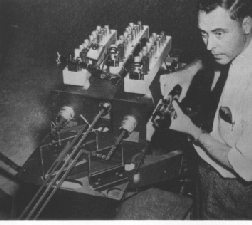
Richard C. Webb, Designer of the First Simultaneous All-Electronic Color CameraWebb, in a January 17, 1997 conversation, described the challenge of achieving optical and electrical registration of the three color channels during his design of this first color camera.
Wardman Park Studio Color CamerasAt least three finished studio cameras of this type were built by the Television Research Group of RCA Laboratories and two were installed in the NBC Studios at the Wardman Park Hotel in Washington, D.C. The cameras were used for the demonstrations of the RCA Dot-Sequential Color Television System to the F.C.C. during the color television hearings in 1949 through 1950. The body of the camera was painted the early RCA "light and dark umber-gray" (tan) color scheme.
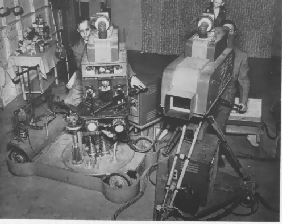
Bob Johnson behind the controls of the left Wardman Park Color CameraRichard Webb said he "lived in Washington for almost a year" supporting the Wardman Park color equipment during the FCC hearings. He described Bob Johnson, of RCA Lancaster, spending hours in his search for matched Image Orthicon tubes for these cameras.
RCA Building Studio 3H Color Cameras After the FCC rejection of the RCA Dot Sequential Color System, further color camera development responsibility was transferred from RCA Laboratories to the RCA Engineering Products Department (Broadcast Equipment Group) in Camden. Studio development activity was moved from Washington to the RCA building in New York City.
Between July,1951 and 1953, Studio 3H at Rockefeller Center supported the testing of the evolving NTSC standard. A series of experimental broadcasts from the Empire State Building were made using this type of camera. Now, these large, square front, cameras used a single objective lens. The cameraman could now select from four different focal lengths by rotating a lens turret. Director selection of cameras was done by switching the component R,G,B signals. A single colorplexer was used at the output of this switcher to encode the components of the selected camera into a composite NTSC signal.
Colonial Theater Color CamerasThe first large production color studio was built by NBC at the New York Colonial Theater. The first experimental demonstrations to the FCC in May, 1953 came from this studio.
TK-40 Color Camera at the Colonial TheaterThe Colonial Theater installation employed the TK-40 Camera. The camera's width was tapered toward the front to reduce bulk, and the cameras were painted silver. There were no side cooling vents in its viewfinder, as with the later production TK-40A camera.
Marie McNamara (Miss Color TV) and TK-40 Camera during a Remote Pick-upThe first NBC colorcasts came from this studio, including the October 31, 1953 opera Carmen and the November 22, 1953 Colgate Comedy Hour, with Donald O'Connor (the first commercial colorcast). [Note: these colorcasts were only viewed in color by closed circuit. The color burst was removed before being broadcast, and the programs were seen by the general public only in black in white].
TK-40 Camera Colorcasting the October 31, 1953 "Carmen"
The TK-40A Color Camera Initial deliveries by RCA Broadcast, of the first commercial color camera produced in quantity, were of a "TK-40A" camera starting in March, 1954. TK-40As were provided to CBS for their Fall 1954 shows from their New York Studio 72 (Broadway at 81st. St.) and Hollywood Television City Studio 43C (Beverly and Fairfax). They were also used in the new NBC Brooklyn 1 Studio, starting with the first color spectacular, the Sept. 12, 1954 "Satins and Spurs" with Betty Hutton. The body of the TK-40A camera appeared identical to the later TK-41.
TK-40As were provided to local affiliates including WKY-TV (Oklahoma City for their first April 8, 1954 colorcast), WBAP-TV (Fort Worth, May 15, 1954), WTMJ-TV (Milwaukee, July 18,1954), WBEN (Buffalo), WCCO-TV (Minneapolis), and KTLA (Los Angeles). Shortly after these deliveries, the TK-41 camera was introduced with significantly reduced rack space, tube count, and power requirements. The TK-41 Color Camera The TK-41, introduced in late 1954, was the workhorse of the color television industry for more than 15 years. The camera head and viewfinder, weighing 310 pounds, was 21-inches wide, 27-inches high, and, including lenses and viewing hood, was nearly 5-feet in length. The camera and studio pedestal combination weighed 1000 pounds. It is impressive to see the fluid movements of this cumbersome camera as seen on early kinescopes and restored color video tapes in the UCLA Film and Television Archive collection.
The Production TK-41 Color Camera(TK-41C previously owned by Red Skelton) The Collection of Television Technology, UCLA Film and Television Archive The camera had a four-lens turret, a flat-plate dichroic mirror assembly for beam splitting, and three 3-inch image orthicon pickup tubes. Later, with the TK-41C series, the camera was modified to use prism optics for image splitting. Horizontal and vertical deflection amplifiers, and a 7-inch viewfinder completed the head. Three heavy cables were routed to the control room where there was a camera control panel, processing amplifier, monitor, aperture compensation, power supply equipments, and a colorplexer to encode the R,G,B signals into the composite NTSC signal. These equipments required 96-inches of rack space, and a 13-inch and 19-inch high control panels. More than 3.2 KW of power was required for each 270-tube vacuum tube camera chain.
The TK-41 series continued through TK-41A, TK-41B, and TK-41C models. KMTV (Omaha) became operational with its TK-41s starting in September, 1955. Future updates to this section will describe the unique G.E.-CBS Chromacoder and DuMont Vitascan live pickup color cameras. Early Flying-Spot 16MM and 35MM film cameras were also produced by Philco, DuMont, and General Electric. Also described will be later 4-tube RCA and GE live cameras and the second-generation Plumbicon cameras of the early 1960's that ended RCA's dominance of color studio equipments.
To be continued.....
For a superb web site that features many photos of black & white and color television cameras, go to Chuck Pharis' Television Site This page of Ed Reitan is a work in progress. V2.0.4 06/24/2001
|
